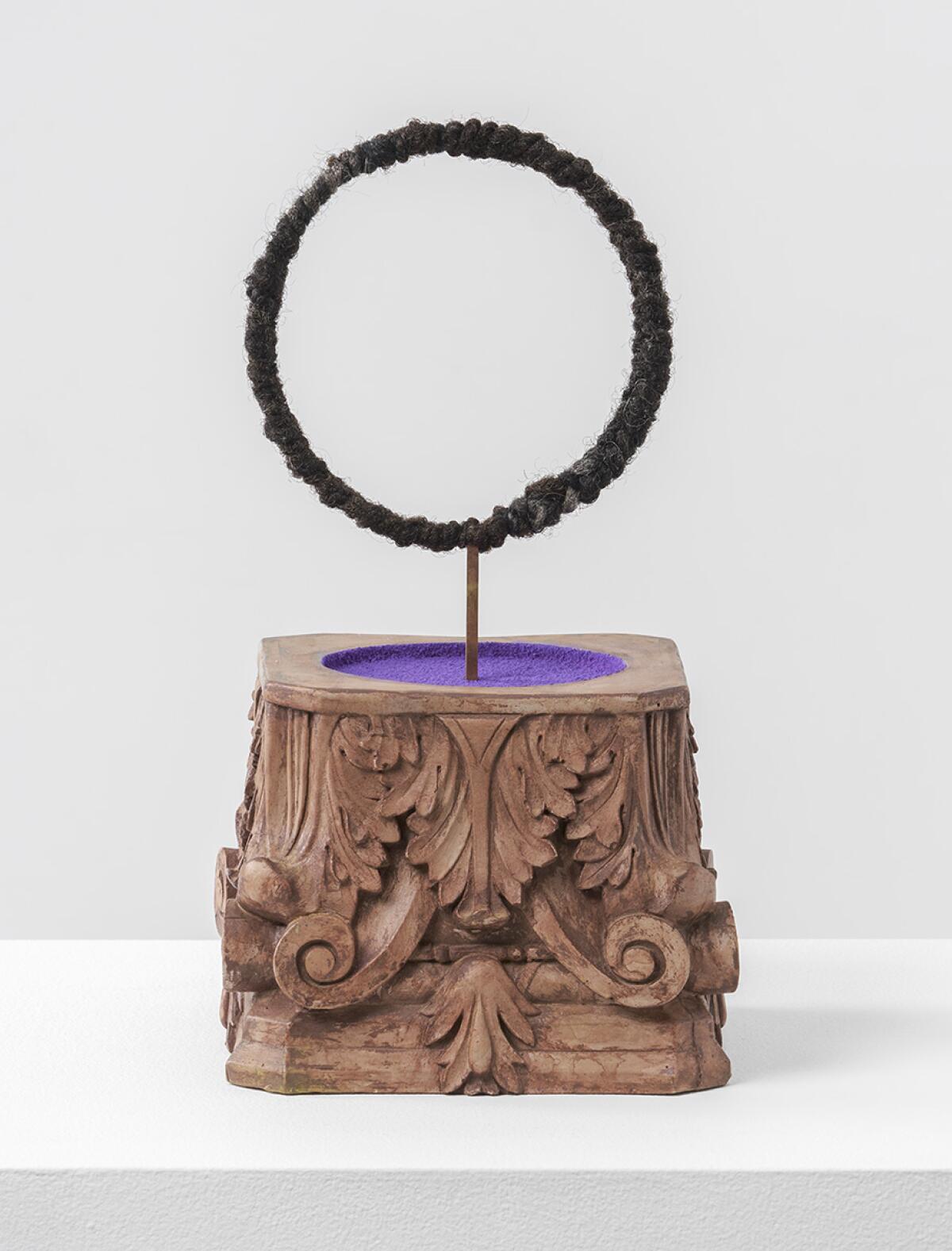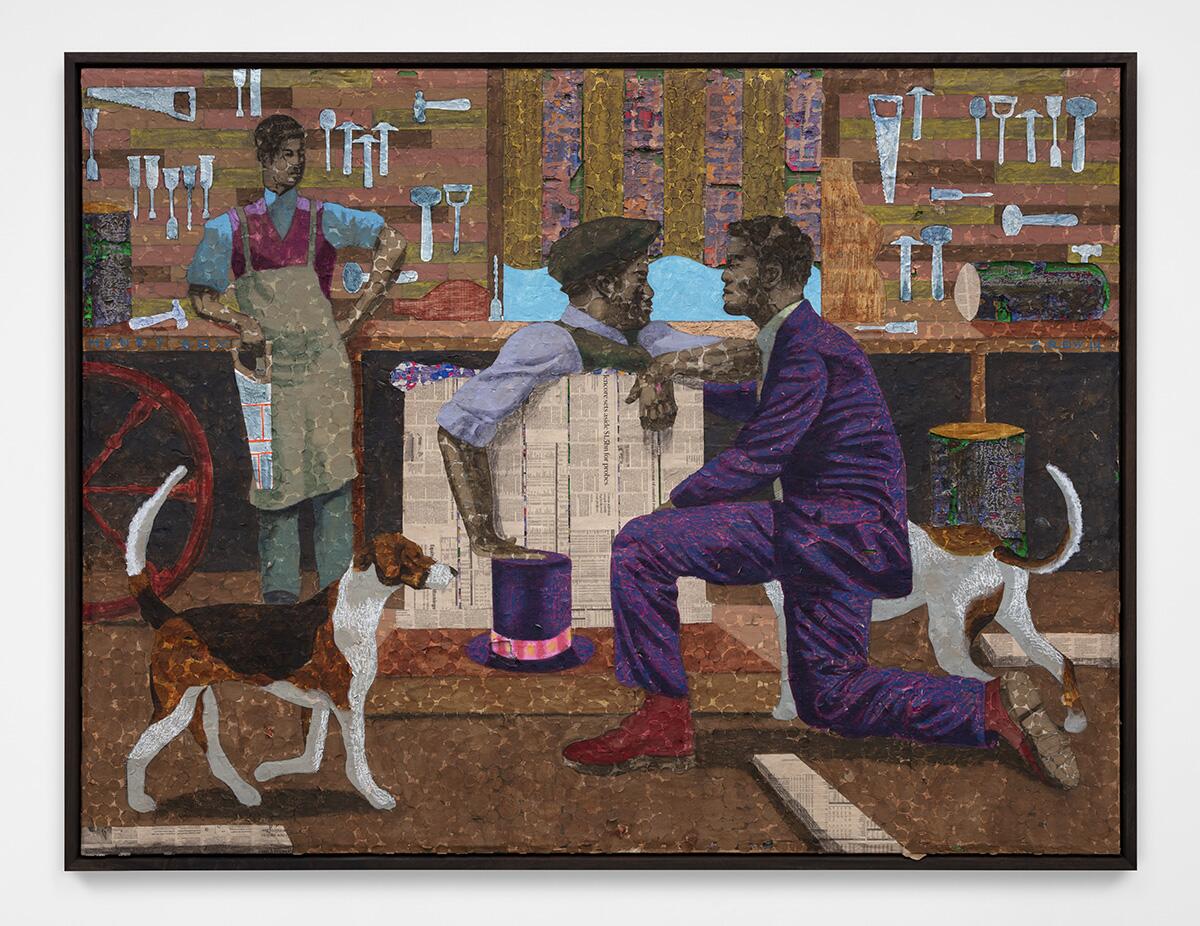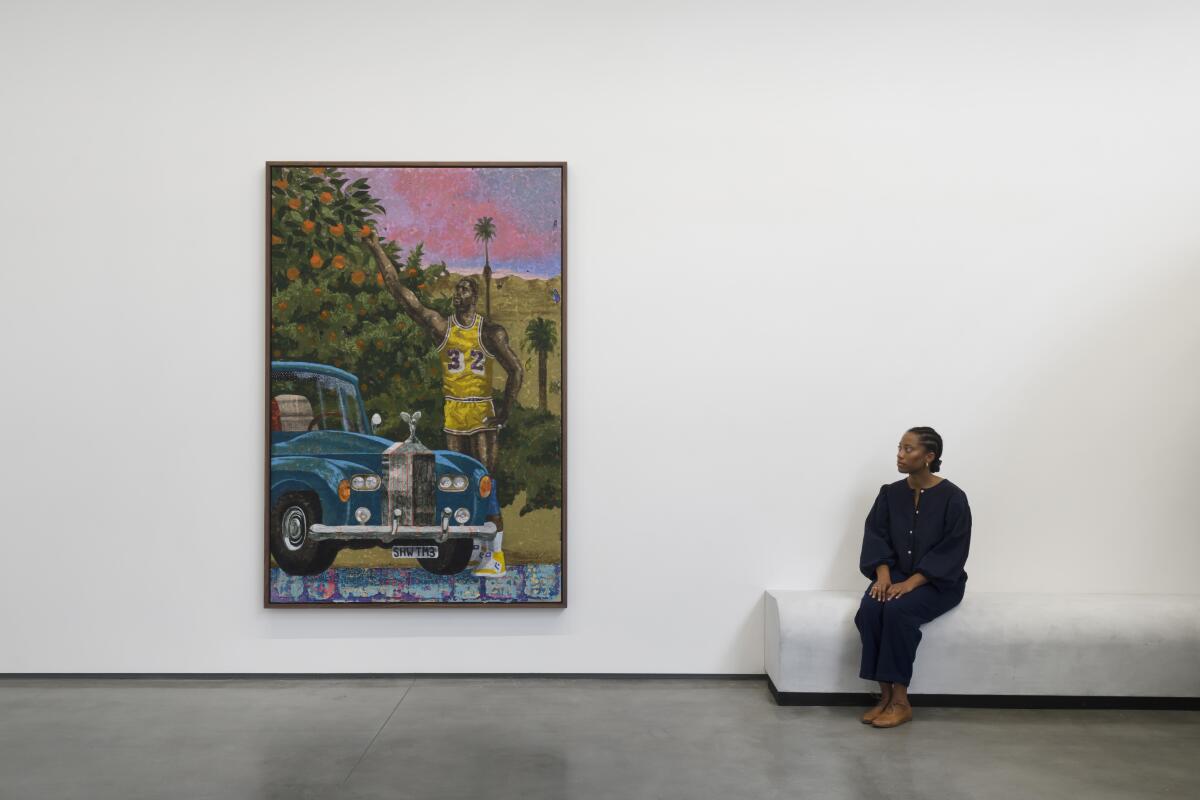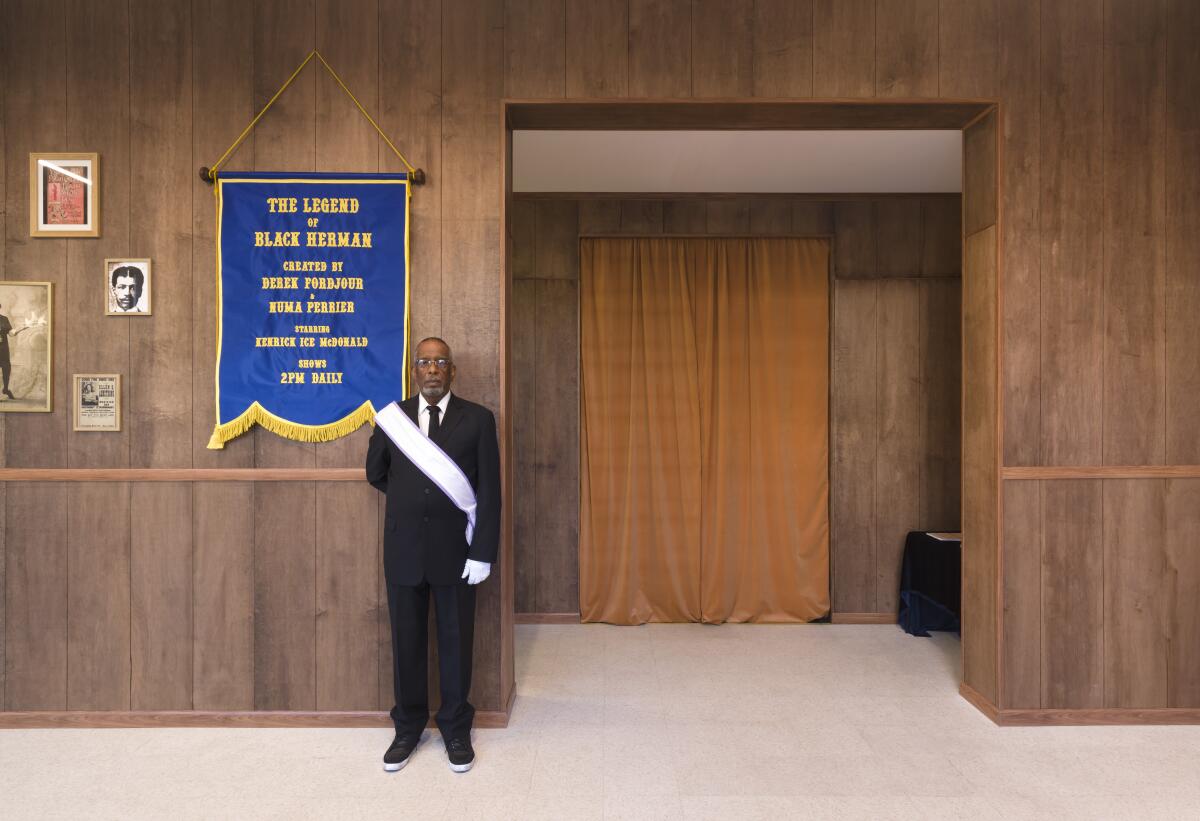Derek Fordjour examines magic, race and revelry in two L.A. art installations

- Share via
Standing in front of Derek Fordjour’s mural “Sonic Boom,” you can almost hear the drum major’s whistle chirping and the drum line keeping the beat. The marching band and prancing dancers forming Fordjour’s newly unveiled procession down Grand Avenue are just that lively.
The 5,400-square-foot mural currently blankets the facade of the Museum of Contemporary Art with vibrant colors and a sense of both exuberance and pageantry. It’s part of the MOCA Building Art series of outdoor artworks and is one of two major installations Fordjour debuted in Los Angeles in late March.
Also on display in an exhibition at David Kordansky Gallery, the New York-based artist’s latest works display facets of African American culture that are steeped in tradition — from the widely celebrated to the obscure to the surreal.
Fordjour’s inspiration for the MOCA commission was the Jackson State University marching band, known as the “Sonic Boom of the South.” Watching the historically Black college ensemble perform in annual band competitions was a highlight of his childhood in Memphis, Tenn.
He presented the museum with four mural options — in addition to the HBCU band tribute, he submitted depictions of unsung African American rowing crews and horse jockeys, as well as portraits of Black males presented in the style of urban memorial murals. He wanted the entire museum staff to vote on the selections in order to instill in them a sense of personal investment in the final piece.
”Everyone from the head curator to the security and maintenance staff would have a voice in choosing which option they went for,” Fordjour explains of his process. “I really wanted to make sure that we had diversity of opinion, lived experience and geography in the people that made this decision. I’m not there. This is their building. They really are the stewards of the experience.”
He enlisted still more Angelenos to help him stage “Magic, Mystery & Legerdemain,” his ambitious ode to arcana at David Kordansky Gallery. The immersive exhibition, which runs at the Mid-Wilshire space through May 7, explores magic as it relates to race and American history. L.A.-based master magician Kenrick “Ice” McDonald, filmmaker Numa Perrier, floral artist Maurice Harris and other local creatives lent their talents to transform the typical gallery experience into something uncanny, eccentric and educational.
The show features paintings, sculptures and a live magic performance sparked by the artist’s research into historic African American illusionists such as Richard Potter, Ellen E. Armstrong and Black Herman, as well as Candomblé rituals practiced by enslaved Africans in Brazil. This deep dive into the past was triggered by Fordjour’s bafflement surrounding present-day events.

“I started thinking about magic as an allegory for privilege,” he says. “You know the Kyle Rittenhouse verdict? The young man who murdered those people? He’s out! I have friends who have done more time for far less than murder, so that felt like a magic trick. Like, ‘Wow! How did he do that in plain view?!’”
“There is something about my vantage, as a Black person living in this society, where the rules just seem to change conveniently in ways that affirm the white supremacist structure in which we operate. Magic was a perfect way to discuss some of this.”
To begin his journey through the looking glass, as it were, gallery visitors must first push past a thick, velvety curtain and step into a dimly lit vestibule. There, pages from the Financial Times line the walls and ceiling. Think of it as a behind-the-scenes reveal — the artist’s signature painting style is achieved by applying rich, saturated colors atop layers of cardboard and that same newspaper’s pale pink pages.

A small black-and-white television mounted on the wall plays vintage footage of a televised performance by magician Frank Brents. Below it, a podium holds an upturned top hat filled with a fresh floral bouquet. Here, again, the artist offers a sneak peek of what awaits beyond the entryway. Each week, Harris creates a different “floral portrait” inspired by the exhibition’s paintings. The two collaborators have dubbed the podium space “the Top Hat Residency.”
“I was interested in how a floral arrangement can interact with the illusion of a magic trick or create the spark that magic does,” said Harris, the owner of the Echo Park floral design studio Bloom & Plume. “I’ve been pulling in stems like allium because they have a firework quality to them, James Storie orchids because they’re flowy but explosive, and I’ve been drawn to a specific palette of roses because they mirror the color vocabulary that I often see in Derek’s work.”
The paintings on display beyond the antechamber play on themes of spectacle, public perception and sleight of hand. The first piece, “Cargo,” is a tribute to Henry “Box” Brown, an enslaved Virginia man who famously mailed himself in a crate to abolitionists in Philadelphia.

In “Cotillion,” prim debutantes and their tuxedo-clad partners dance around a ballroom, representing Fordjour’s view of the centuries-old rite as a sort of illusion in which middle-class Black families enshroud their challenging social circumstances in order to create a moment of grandeur.
“Birth of Showtime” depicts Lakers legend Earvin Johnson Jr. in the early days of his basketball fame. The subtext here is that the NBA star’s nickname was “an invention of the white gaze,” as Fordjour puts it. “He didn’t name himself Magic. His mother did not name him Magic. A white male reporter did,” he says. “I found that to be really interesting because this idea of magic in Black people, through the white imagination, is something that persists.”

In keeping with the show’s experiential approach, Fordjour is also staging a live magic show honoring Black Herman (born Benjamin Rucker), whose 1925 book inspired the exhibition’s title. At 2 p.m. Tuesdays through Saturdays, visitors can file into a small theater constructed to evoke elementary school auditoriums or church basements. There, modern-day magician McDonald portrays Herman in a 20-minute production written and directed by Perrier. Along with Nubia Bowe, who plays his assistant, he creates onstage illusions while acting out highlights of Herman’s fantastical exploits.
Perrier infused “The Legend of Black Herman” with elements that range from kitschy to sensual, adding notes of vaudeville, carnival acts and church sermons. A solemn usher, a suited organist, melodramatic narration and glitzy costumes all help set the mysterious tone.
“I want the audience to lose themselves in the magic and, just for those moments, let it overtake them,” she says. “I want them to feel the sense of wonder, pain and seduction that’s all inside of the show.”

Suspension of disbelief is key when delving into any magician’s world, but Herman’s more so than others. Fordjour was drawn in by Herman’s over-the-top claims of learning magic from a Zulu tribe and by stunts like his famed “buried alive” trick, wherein he appeared to inter himself for three days prior to a performance, then rise and lead awed onlookers to his stage show.
“He was a little bit of a hustler, in my opinion,” Fordjour says. “I liked that I didn’t know how much of Black Herman to believe and not believe.”
“That’s the crux of the [magic] show. Numa and I worked to really foreground the question: Are you going to allow me — as a Black man — to deceive you in plain sight? Are you going to afford me that?”
Derek Fordjour
What: “Magic, Mystery & Legerdemain”
Where: David Kordansky Gallery, 5130 W. Edgewood Place
When: Tues-Sat 10 a.m.-6 p.m. Through May 7. Magic performances by Kenrick “Ice” McDonald, 2 p.m. Tuesdays through Saturdays
Contact: (323) 935-3030, davidkordanskygallery.com
What: “Sonic Boom”
Where: MOCA Grand Avenue, 250 S. Grand Ave.
When: Ongoing
Contact: (213) 626-6222, moca.org
More to Read
The biggest entertainment stories
Get our big stories about Hollywood, film, television, music, arts, culture and more right in your inbox as soon as they publish.
You may occasionally receive promotional content from the Los Angeles Times.










